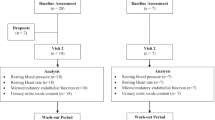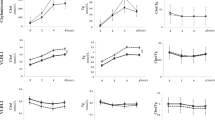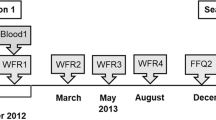Abstract
Background/objectives:
Epidemiological studies suggest that apple consumption is associated with a reduction in cardiovascular disease risk. Apple polyphenols may contribute to explain these effects. Endothelial dysfunction has been associated with early stage of atherosclerosis and polyphenols from various dietary sources have been shown to reverse it. The aim of the present study was to investigate the effect of the consumption of a polyphenol-rich apple on endothelial function.
Subjects/methods:
In all, 30 hypercholesterolemic volunteers were included in a double-blind, randomized crossover trial. They successively consumed 40 g of two lyophilized apples, polyphenol-rich and polyphenol-poor, providing respectively 1.43 and 0.21 g polyphenols per day during two 4-week periods separated by a 4-week washout period.
Results:
Brachial artery flow-mediated vasodilation (FMD) was assessed at the beginning and at the end of each intervention period. FMD did not differ between the polyphenol-rich and the polyphenol-poor apples, neither did the other cardiovascular disease risk factors (plasma lipids, homocysteine, antioxidant capacity).
Conclusions:
These data suggest that over a 4-week period, the consumption of a polyphenol-rich apple does not improve vascular function in hypercholesterolemic patients.
This is a preview of subscription content, access via your institution
Access options
Subscribe to this journal
Receive 12 print issues and online access
$259.00 per year
only $21.58 per issue
Buy this article
- Purchase on Springer Link
- Instant access to full article PDF
Prices may be subject to local taxes which are calculated during checkout


Similar content being viewed by others
References
Anderson TJ, Uehata A, Gerhard MD, Meredith IT, Knab S, Delagrange D et al. (1995). Close relation of endothelial function in the human coronary and peripheral circulations. J Am Coll Cardiol 26, 1235–1241.
Appeldoorn MM, Venema DP, Peters TH, Koenen ME, Arts IC, Vincken JP et al. (2009). Some phenolic compounds increase the nitric oxide level in endothelial cells in vitro. J Agric Food Chem 57, 7693–7699.
Aprikian O, Levrat-Verny MA, Besson C, Busserolles J, Remesy C, Demigne C (2001). Apple favourably affects parameters of cholesterol metabolism and of anti-oxidative protection in cholesterol-fed rats. Food Chem 75, 445–452.
Bai Y, Sun L, Yang T, Sun K, Chen J, Hui R (2009). Increase in fasting vascular endothelial function after short-term oral L-arginine is effective when baseline flow-mediated dilation is low: a meta-analysis of randomized controlled trials. Am J Clin Nutr 89, 77–84.
Balzer J, Rassaf T, Heiss C, Kleinbongard P, Lauer T, Merx M et al. (2008). Sustained benefits in vascular function through flavanol-containing cocoa in medicated diabetic patients a double-masked, randomized, controlled trial. J Am Coll Cardiol 51, 2141–2149.
Benzie IF, Strain JJ (1996). The ferric reducing ability of plasma (FRAP) as a measure of “antioxidant power”: the FRAP assay. Anal Biochem 239, 70–76.
Blacher J, Demuth K, Guerin AP, Safar ME, Moatti N, London GM (1998). Influence of biochemical alterations on arterial stiffness in patients with end-stage renal disease. Arterioscler Thromb Vasc Biol 18, 535–541.
Brock DW, Davis CK, Irving BA, Rodriguez J, Barrett EJ, Weltman A et al. (2006). A high-carbohydrate, high-fiber meal improves endothelial function in adults with the metabolic syndrome. Diabetes Care 29, 2313–2315.
Celermajer DS, Adams MR, Clarkson P, Robinson J, McCredie R, Donald A et al. (1996). Passive smoking and impaired endothelium-dependent arterial dilatation in healthy young adults. N Engl J Med 334, 150–154.
Celermajer DS, Sorensen KE, Bull C, Robinson J, Deanfield JE (1994). Endothelium-dependent dilation in the systemic arteries of asymptomatic subjects relates to coronary risk factors and their interaction. J Am Coll Cardiol 24, 1468–1474.
Celermajer DS, Sorensen KE, Georgakopoulos D, Bull C, Thomas O, Robinson J et al. (1993). Cigarette smoking is associated with dose-related and potentially reversible impairment of endothelium-dependent dilation in healthy young adults. Circulation 88, 2149–2155.
Chironi G, Craiem D, Miranda-Lacet J, Levenson J, Simon A (2008). Impact of shear stimulus, risk factor burden and early atherosclerosis on the time-course of brachial artery flow-mediated vasodilation. J Hypertens 26, 508–515.
Chopra M, O'Neill ME, Keogh N, Wortley G, Southon S, Thurnham DI (2000). Influence of increased fruit and vegetable intake on plasma and lipoprotein carotenoids and LDL oxidation in smokers and nonsmokers. Clin Chem 46, 1818–1829.
Chow HH, Hakim IA, Crowell JA, Ranger-moore J, Chew WM, Celaya CA et al. (2005). Effects of dosing condition on the oral bioavailability of green tea catechins after single-dose administration of polyphenon E in healthy individuals. Clin Cancer Res 11, 4627–4633.
Craiem D, Chironi G, Gariepy J, Miranda-Lacet J, Levenson J, Simon A (2007). New monitoring software for larger clinical application of brachial artery flow-mediated vasodilatation measurements. J Hypertens 25, 133–140.
Dauchet L, Amouyel P, Dallongeville J (2009). Fruits, vegetables and coronary heart disease. Nat Rev Cardiol 6, 599–608.
Déprez S, Mila I, Huneau J-F, Tom D, Scalbert A (2001). Transport of proanthocyanidin dimer, trimer and polymer across monolayers of human intestinal epithelial Caco-2 cells. Antioxid Redox Signal 3, 957–967.
Donovan JL, Manach C, Rios L, Morand C, Scalbert A, Remesy C (2002). Procyanidins are not bioavailable in rats fed a single meal containing a grapeseed extract or the procyanidin dimer B3. Br J Nutr 87, 299–306.
Duffy SJ, Keaney Jr JF., Holbrook M, Gokce N, Swerdloff PL, Frei B et al. (2001). Short- and long-term black tea consumption reverses endothelial dysfunction in patients with coronary artery disease. Circulation 104, 151–156.
Egert S, Bosy-Westphal A, Seiberl J, Kürbitz C, Settler U, Plachta-Danielzik S et al. (2009). Quercetin reduces systolic blood pressure and plasma oxidised low-density lipoprotein concentrations in overweight subjects with a high-cardiovascular disease risk phenotype: a double-blinded, placebo-controlled cross-over study. Br J Nutr 102, 1065–1074.
Ellingsen I, Hjerkinn EA, Sejeflot I, Arnesen H, Tonstad S (2008). Consumption of fruit and berries is inversely associated with carotid atherosclerosis in elderly men. Br J Nutr 99, 674–681.
Farouque HM, Leung M, Hope SA, Baldi M, Schechter C, Cameron JD et al. (2006). Acute and chronic effects of flavanol-rich cocoa on vascular function in subjects with coronary artery disease: a randomized double-blind placebo-controlled study. Clin Sci (Lond) 111, 71–80.
Felgines C, Texier O, Besson C, Lyan B, Lamaison JL, Scalbert A (2007). Strawberry pelargonidin glycosides are excreted in urine as intact glycosides and glucuronidated pelargonidin derivatives in rats. Br J Nutr 98, 1126–1131.
Fournier N, Francone O, Rothblat G, Goudouneche D, Cambillau M, Kellner-Weibel G et al. (2003). Enhanced efflux of cholesterol from ABCA1-expressing macrophages to serum from type IV hypertriglyceridemic subjects. Atherosclerosis 171, 287–293.
Gonthier M-P, Donovan JL, Texier O, Felgines C, Remesy C, Scalbert A (2003). Metabolism of dietary procyanidins in rats. Free Radic Biol Med 35, 837–844.
Guyot S, Marnet N, Sanoner P, Drilleau JF (2001). Direct thiolysis on crude apple materials for high-performance liquid chromatography characterization and quantification of polyphenols in cider apple tissues and juices. Methods Enzymol 335, 57–70.
Heiss C, Finis D, Kleinbongard P, Hoffmann A, Rassaf T, Kelm M et al. (2007). Sustained increase in flow-mediated dilation after daily intake of high-flavanol cocoa drink over 1 week. J Cardiovasc Pharmacol 49, 74–80.
Heitzer T, Schlinzig T, Krohn K, Meinertz T, Munzel T (2001). Endothelial dysfunction, oxidative stress, and risk of cardiovascular events in patients with coronary artery disease. Circulation 104, 2673–2678.
Holt RR, Lazarus SA, Sullards MC, Zhu QY, Schramm DD, Hammerstone GF et al. (2002). Procyanidin dimer B2 (epicatechin-(4b-8)-epicatechin) in human plasma after the consumption of a flavanol-rich cocoa. Am J Clin Nutr 76, 798–804.
Hooper L, Kroon PA, Rimm EB, Cohn JS, Harvey I, Le Cornu KA et al. (2008). Flavonoids, flavonoid-rich foods, and cardiovascular risk: a meta-analysis of randomized controlled trials. Am J Clin Nutr 88, 38–50.
Huang DJ, Ou BX, Hampsch-Woodill M, Flanagan JA, Prior RL (2002). High-throughput assay of oxygen radical absorbance capacity (ORAC) using a multichannel liquid handling system coupled with a microplate flourescence reader in 96-well format. J Agric Food Chem 50, 4437–4444.
Ito H, Gonthier MP, Manach C, Morand C, Mennen L, Remesy C et al. (2005). Polyphenol levels in human urine after intake of six different polyphenol-rich beverages. Br J Nutr 94, 500–509.
Knekt P, Jarvinen R, Reunanen A, Maatela J (1996). Flavonoid intake and coronary mortality in Finland: a cohort study. BMJ 312, 478–481.
Kuvin JT, Karas RH (2003). Clinical utility of endothelial function testing: ready for prime time? Circulation 107, 3243–3247.
Leontowicz H, Gorinstein S, Lojek A, Leontowicz M, Ciz M, Soliva-Fortuny R et al. (2002). Comparative content of some bioactive compounds in apples, peaches and pears and their influence on lipids and antioxidant capacity in rats. J Nutr Biochem 13, 603–610.
Levenson J, Pessana F, Gariepy J, Armentano R, Simon A (2001). Gender differences in wall shear-mediated brachial artery vasoconstriction and vasodilation. J Am Coll Cardiol 38, 1668–1674.
Li S-H, Liu X-X, Bai Y-Y, Wang X-J, Sun K, Chen J-Z et al. (2010). Effect of oral isoflavone supplementation on vascular endothelial function in postmenopausal women: a meta-analysis of randomized placebo-controlled trials. Am J Clin Nutr 91, 480–486.
Lotito SB, Frei B (2004). The increase in human plasma antioxidant capacity after apple consumption is due to the metabolic effect of fructose on urate, not apple-derived antioxidant flavonoids. Free Radic Biol Med 37, 251–258.
Maas R, Schwedhelm E, Kahl L, Li H, Benndorf R, Luneburg N et al. (2008). Simultaneous assessment of endothelial function, nitric oxide synthase activity, nitric oxide-mediated signaling, and oxidative stress in individuals with and without hypercholesterolemia. Clin Chem 54, 292–300.
Manach C, Mazur A, Scalbert A (2005a). Polyphenols and prevention of cardiovascular diseases. Curr Opin Lipidol 16, 77–84.
Manach C, Williamson G, Morand C, Scalbert A, Remesy C (2005b). Bioavailability and bioefficacy of polyphenols in humans. I. Review of 97 bioavailability studies. Am J Clin Nutr 81, 230S–242S.
Massiot P, Renard C (1997). Composition, physico-chemical properties and enzymatic degradation of fibres prepared from different tissues of apple. Food Sci Technol (Lebensmittel-Wiss Technol) 30, 800–806.
Mennen LI, Sapinho D, Ito H, Bertrais S, Galan P, Hercberg S et al. (2006). Urinary flavonoids and phenolic acids as biomarkers of intake for polyphenol-rich foods. Br J Nutr 96, 191–198.
Mink PJ, Scrafford CG, Barraj LM, Harnack L, Hong CP, Nettleton JA et al. (2007). Flavonoid intake and cardiovascular disease mortality: a prospective study in postmenopausal women. Am J Clin Nutr 85, 895–909.
Missang CE, Renard CMGC, Baron A, Drilleau J-F (2001). Changes in the pectic fraction of bush butter (Dacryodes edulis (G Don) HJ Lam) fruit pulp during ripening. J Sc Food Agric 81, 781–789.
Mweva S, Paul JL, Cambillau M, Goudouneche D, Beaune P, Simon A et al. (2006). Comparison of different cellular models measuring in vitro the whole human serum cholesterol efflux capacity. Eur J Clin Invest 36, 552–559.
Pearson DA, Tan CH, German JB, Davis PA, Gershwin ME (1999). Apple juice inhibits human low density lipoprotein oxidation. Life Sci 64, 1913–1920.
Renard C (2005). Variability in cell wall preparations: quantification and comparison of common methods. Carbohydr Polym 60, 515–522.
Rios LY, Gonthier MP, Remesy C, Mila I, Lapierre C, Lazarus SA et al. (2003). Chocolate intake increases urinary excretion of polyphenol-derived phenolic acids in healthy human subjects. Am J Clin Nutr 77, 912–918.
Sabboh-Jourdan H, Valla F, Epriliati I, Gidley MJ (2010). Organic acid bioavailability from banana and sweet potato using an in vitro digestion and Caco-2 cell model. Eur J Nutr doi:10.1007/s00394-00010-00112-00390.
Schroeter H, Heiss C, Balzer J, Kleinbongard P, Keen CL, Hollenberg NK et al. (2006). (−)-Epicatechin mediates beneficial effects of flavanol-rich cocoa on vascular function in humans. Proc Natl Acad Sci USA 103, 1024–1029.
Sesso HD, Gaziano JM, Liu S, Buring JE (2003). Flavonoid intake and the risk of cardiovascular disease in women. Am J Clin Nutr 77, 1400–1408.
Silaste ML, Rantala M, Alfthan G, Aro A, Kesaniemi YA (2003). Plasma homocysteine concentration is decreased by dietary intervention. Br J Nutr 89, 295–301.
Simon E, Paul JL, Atger V, Simon A, Moatti N (2000). Study of vitamin E net mass transfer between alpha-tocopherol-enriched HDL and erythrocytes: application to asymptomatic hypercholesterolemic men. Free Radic Biol Med 28, 815–823.
Tessier F, Birlouez-Aragon I, Tjani C, Guilland JC (1996). Validation of a micromethod for determining oxidized and reduced vitamin C in plasma by HPLC-fluorescence. Int J Vitam Nutr Res 66, 166–170.
Ting HH, Timimi FK, Haley EA, Roddy MA, Ganz P, Creager MA (1997). Vitamin C improves endothelium-dependent vasodilation in forearm resistance vessels of humans with hypercholesterolemia. Circulation 95, 2617–2622.
Verma S, Buchanan MR, Anderson TJ (2003). Endothelial function testing as a biomarker of vascular disease. Circulation 108, 2054–2059.
Widlansky ME, Hamburg NM, Anter E, Holbrook M, Kahn DF, Elliott JG et al. (2007). Acute EGCG supplementation reverses endothelial dysfunction in patients with coronary artery disease. J Am Coll Nutr 26, 95–102.
Acknowledgements
This work was supported by the European Community (FLAVO-FOOD-CT-2004-513960).
Author information
Authors and Affiliations
Corresponding author
Ethics declarations
Competing interests
The authors declare no conflict of interest.
Rights and permissions
About this article
Cite this article
Auclair, S., Chironi, G., Milenkovic, D. et al. The regular consumption of a polyphenol-rich apple does not influence endothelial function: a randomised double-blind trial in hypercholesterolemic adults. Eur J Clin Nutr 64, 1158–1165 (2010). https://doi.org/10.1038/ejcn.2010.135
Received:
Revised:
Accepted:
Published:
Issue Date:
DOI: https://doi.org/10.1038/ejcn.2010.135
Keywords
This article is cited by
-
Caloric restriction-mimetics for the reduction of heart failure risk in aging heart: with consideration of gender-related differences
Military Medical Research (2022)
-
Two apples a day modulate human:microbiome co-metabolic processing of polyphenols, tyrosine and tryptophan
European Journal of Nutrition (2020)
-
Food intake biomarkers for apple, pear, and stone fruit
Genes & Nutrition (2018)
-
Oxidative Stress and Early Atherosclerosis: Novel Antioxidant Treatment
Cardiovascular Drugs and Therapy (2015)
-
Effects of regular consumption of vitamin C-rich or polyphenol-rich apple juice on cardiometabolic markers in healthy adults: a randomized crossover trial
European Journal of Nutrition (2014)



